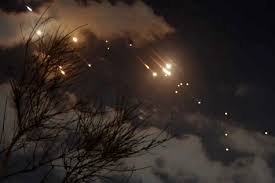
In a dramatic escalation of military conflict in West Asia, Iran launched a large-scale missile offensive against Israel, targeting key military bases in what it called Operation True Promise II. The attack, which occurred Tuesday, marked the second major Iranian strike on Israel in the past seven months, coming in response to the recent killings of Hezbollah chief Hassan Nasrallah and Hamas leader Ismail Haniyeh.
Iran’s Revolutionary Guards claimed responsibility for the attack, releasing a chilling video via Press TV that captured the launch of hundreds of ballistic missiles into the night sky. The footage, shared widely on social media, showed rockets streaking across the horizon, followed by dozens of burning projectiles descending over an urban center. Some were intercepted mid-air, thanks to Israel’s formidable air defense systems, but several appeared to break through and hit the ground.
In one particularly harrowing scene, the final moments of the video show explosions lighting up the skyline, suggesting the missiles had reached populated areas. One missile reportedly created a massive crater near the Mossad headquarters in Tel Aviv. According to CNN, the video of this crater was geolocated to Herzliya, just 3 km from the intelligence agency’s base.
Iran’s missile barrage included over 180 projectiles, including for the first time its Fattah hypersonic missile, which is capable of flying at speeds that make interception exceedingly difficult. The missiles’ flight paths also crossed over Jordan, prompting the kingdom to suspend air traffic as a precautionary measure.
Israel’s defense systems, including the Iron Dome and Arrow, were activated in response to the missile attack. Despite Tehran’s claims that 90% of the missiles hit their targets, Israeli authorities insisted that the majority were intercepted by their advanced anti-missile defenses. No casualties were reported in Israel, though one man was killed in the occupied West Bank.
The April missile strike, which preceded this attack, had also seen Tehran retaliating against an alleged Israeli air strike on its consulate in Damascus, Syria. That strike had resulted in the deaths of seven Iranian Guards officers. In Operation True Promise I, Iran had launched nearly 200 ballistic missiles and explosive drones, but Tel Aviv reported that 99% were intercepted.
Ballistic missiles have long been a cornerstone of Iran’s military capabilities, seen by the regime as a crucial deterrent against Israel and the United States. In addition to ballistic missiles, Iran’s arsenal is believed to include cruise missiles, such as the Kh-55, which have nuclear capabilities, and the Khalid Farzh anti-ship missile. Both missiles are capable of carrying warheads of up to 1,000 kg.
This morning, Iranian authorities announced that their operation had concluded, and no further military action was planned unless provoked. However, Israel, along with the United States, has vowed to retaliate against this significant escalation in regional conflict.
As military tensions continue to rise in West Asia, the international community watches closely, hoping to avoid further violence in an already fragile region.
Sources By Agencies


